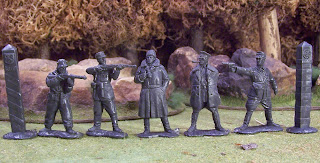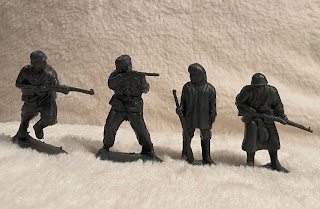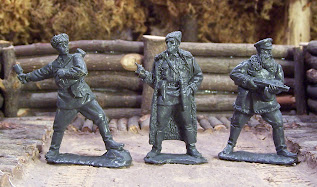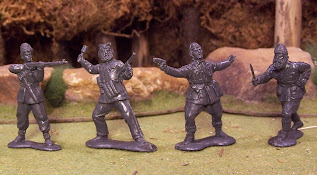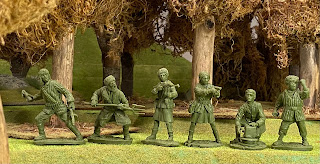Latest edit: Added Hanomak Soviet Partisan horse rider
______________
The term Partisan applies to those units which operated behind enemy lines in order to disrupt the German war effort. Their operations primarily targeted the infrastructure supporting the German front units, such as railways, rail stock, supply depots, bridges, communication centers, etc. and even though their main goal was not to fight the Germans head-on, they did kill a good share of rearguard troops and collaborationist units. Initially the partisan units originated from regular Soviet troops left behind by the rapidly advancing front, and operated in an independent manner. Gradually, the German occupation and the brutal treatment of the local population -deportations, use as slave labor, confiscation of food in the middle of winter, etc.- turned many civilians, towards the partisan ranks. The German reprisals against this movement did not only target the partisans themselves -who were regularly executed-, but often included the execution of civilians, sometimes as many as 100 for each German death. The partisans responded in kind, by not just killing Germans, but sometimes mutilating them in horrible ways. As of mid 1942, the Soviet Central command started to play a role in coordinating and supplying the partisan units. The supplies not only consisted of weapons and material -including badly needed communications equipment-, but also included specially selected and trained troops as well as NKVD members to lead and reinforce the partisans. Many of these were air dropped behind enemy lines, but many also flowed through a 40km wide land corridor known as the Vitsyebsk Gate which was open for a good portion of 1942. Partisan operations gradually became more than local harassments and by 1943, they were well coordinated and timed operations. For instance, during the Kursk offensive, the supply difficulties created by the operations in the German rear played a very important role in halting the summer offensive. Over 100,000 partisans participated in the raids at this time. Another measure of the partisans success is the fact that as the Soviet Army advanced many partisan units were ordered to continue to move west so that they could remain in occupied territory and continue to operate. This was important not just because of the direct impact on the infrastructure, but also because of the large number of German troops which were required to guard the supply lines and to hunt the partisans. Most of those partisans which were liberated by the advancing Soviets joined the regular army and kept fighting on. At the height of the war, over 500,000 partisans were active across the whole length of the front. After the war ended, partisans were treated not much better than Soviet soldiers who had allowed themselves to be taken prisoners, and underwent interrogations by the NKVD, with many of them being sent to labor camps. This is not surprising as experienced guerrilla forces would have been a danger to Stalin's regime. In terms of toy soldiers, there are now several sets out which collectively, do a nice job at depicting the variety of backgrounds in the Partisan ranks. Let's take a look.

Engineer Bassevich Soviet Partisans - Part I
A unique set by Engineer Bassevich. The depiction of these partisans strikes a nice balance between showing them as civilians and soldiers. For example, the guys above might have just joined the partisan unit and are still wearing some of their original clothes and their weaponry is lacking automatic firing.
UPDATE: I had the good fortune of getting some input from Alex, the man behind Engineer Bassevich's figures and he supplied me with a description for some of the figures. For instance, these guys could be used as members of the factory workers Fighter Battalion at Stalingrad during the summer of 1942. If you take out the guy throwing the grenade, who is holding the automatic weapon, they could also be used as members of the People's Militia Division, during the summer of 1941. Automatic weapons were not available outside of the professional army during the earlier part of the war.
Engineer Bassevich Soviet Partisans - Part II
These guys however are more rugged. they could be regular army troops who got left behind the enemy lines and joined the partisans, giving them some badly needed training and leadership. As far as the quality of the figures go, I am quite pleased with this set. They don't have any flashing, and the plastic used to make them feels more dense, making them feel a bit more robust. The level of detail in the sculpting as you can see, is really great.
UPDATE: Thanks to Engineer Bassevich we now know a bit more about the source of inspiration for these figures. The man in the middle is the legendary Sydir Kovpak, leader of the partisan units in the greater Ukraine-Belarus area -see picture below-. He was officially recognized by the Soviet military command and awarded the rank of Major General. The man on the right represents Pyotr Vershigora, who was Kovpak's second in command and eventually also rose to the rank of Major General.
Here is a picture of Major General Sydir Kovpak, partisan leader in the greater Ukraine-Belarus area
Engineer Bassevich Soviet Partisans - Part III
These guys are probably a mix of civilians and ex-soldiers, but have been in the Partisan ranks long enough to have more sophisticated clothes and equipment. A very interesting touch is the kid in the middle, holding a captured German sub-machine gun. I actually saw a picture of such a kid, dressed very much the same way, which was surely the inspiration for the pose.
UPDATE from Engineer Bassevich: The guy on the right, would have belonged to the division of the People's Militia. Maybe a former teacher. He can be used in the Battle of Moscow, along with soldiers from set number 1. The man on the left could have been a regular army officer left behind the enemy lines after his unit was encircled and then he joined the partisans.
Engineer Bassevich Yugoslav Partisans - Part I
Another set of partisans. These are supposed to be Tito's partisans from Yugoslavia, but I think they could pass as partisans from any occupied country. Note that many of them feature long beards though, so if you are strict about cultural matters, maybe that restricts your options. I am actually planning to mix them with the Soviet partisans and have a larger unit of unregulated militia guys.
Engineer Bassevich Yugoslav Partisans - Part II
One thing I like about this set from Engineer Bassevich is that most of the poses are fighting poses and we got a lot fewer guys standing around.
Engineer Bassevich Yugoslav Partisans - Part III
I am OK with a commander standing around, observing the action. The only guy I don't really have much use for is the 'guard' next to the commanding officer.
Plastic Platoon Greek Partisans
This is the second half of the set representing the Greek combatants. Along with them, on the right, is the partisan figure of set 3 of the German Paras. I just put him next to his comrades in the picture so that you can see how it fits with them. What's nice about these figures is to see the men in their local garb. I don't know if that's what they would have worn going to battle, but it certainly makes them look more authentic. There's also a partisan woman. She is dressed in more 'modern' clothes of that time. Interesting to see that these guys seem more determined to fight than the Greek infantry figures, although it stands to reason that these guys lived on the island and the Greek troops were most likely sent there from other parts of Greece to defend it. That would certainly influence their level of resolve.
Hanomak Soviet Partisans
This depicts the wide range of folks who took arms against the German invaders behind enemy lines. You can see fighting age men in Soviet army attire who are likely men who got encircled and left behind the German advance. There are older men fighting with farming gear, there are women who may have been civilians or maybe also Soviet army regulars, and there's even a teenager who is cursing and ready to throw a rock. And there's also the guy operating the radio which allowed them to coordinate their operations with the main Soviet forces. A good set from Hanomak which will complement well the other partisan sets that came before.
Hanomak Soviet Partisan
I had similar feelings about this figure as I did regarding the German Cossack in the sense that it is not much of an action pose, but at least this guy is aiming his subMG, even if the horse is way too relaxed. But if you want to give your partisans some variety so that not all of them are on foot, this is a decent figure to add to your collection. I wonder however how often partisans relied on horses as they seem like they would be much easier to track down. In terms of the sculpting, the figure is fairly average with a few interesting details like the bags on the horse or the rider's googles and mustache.

